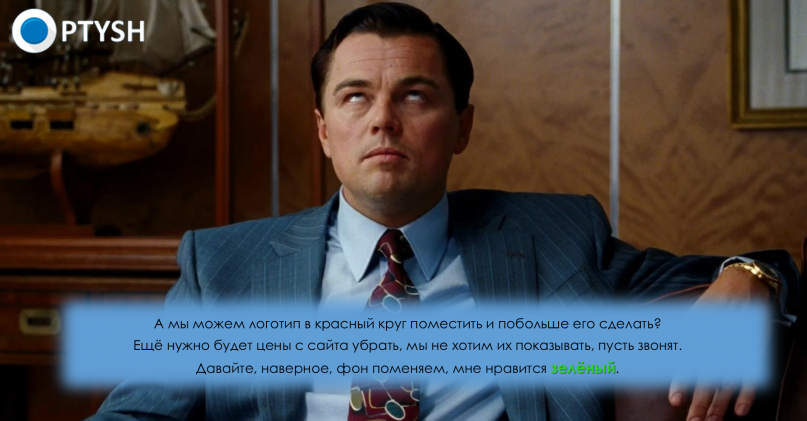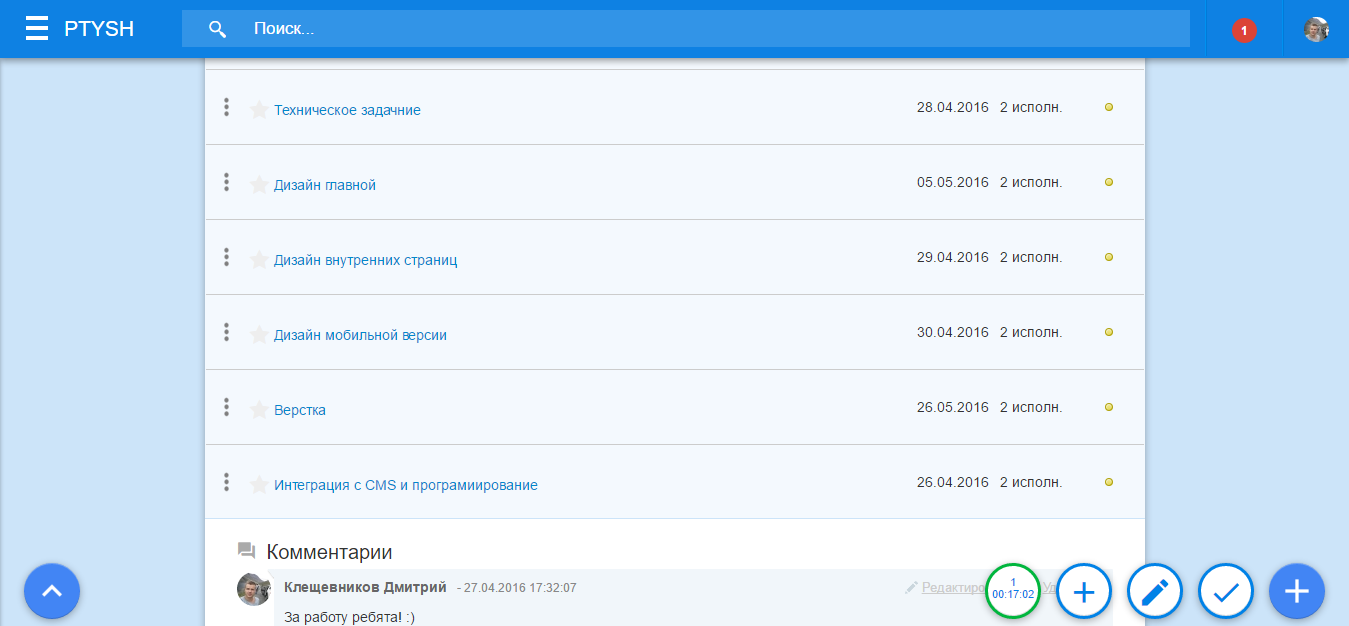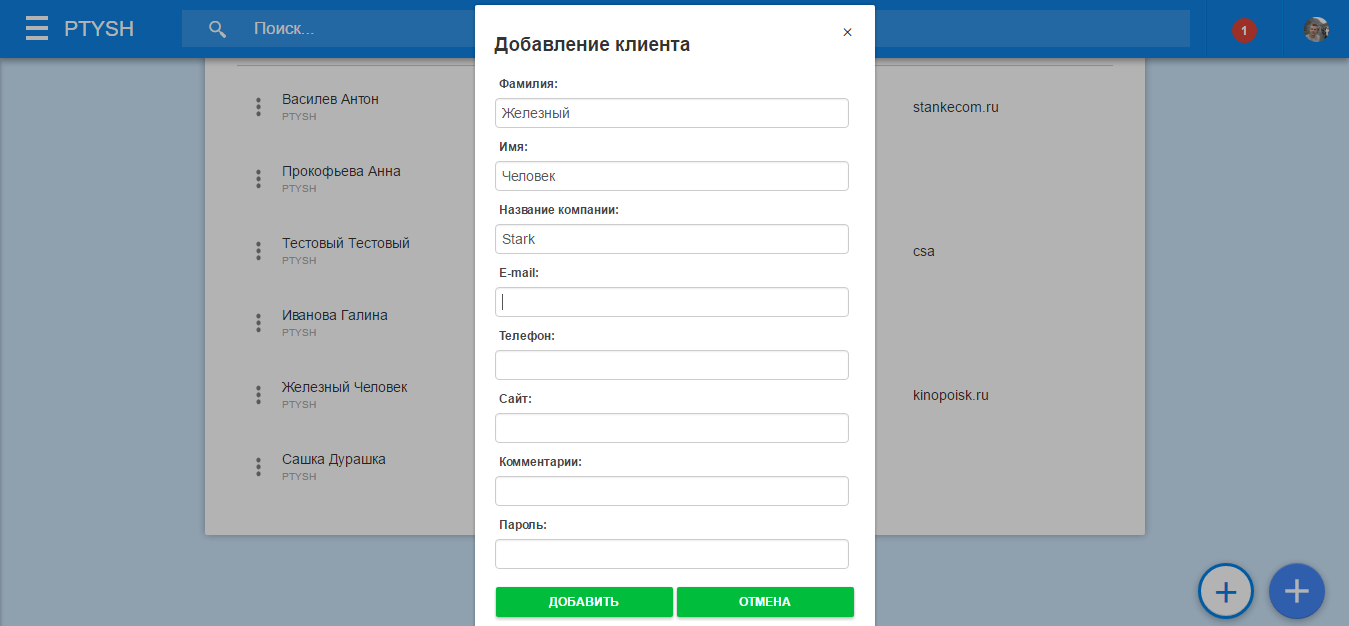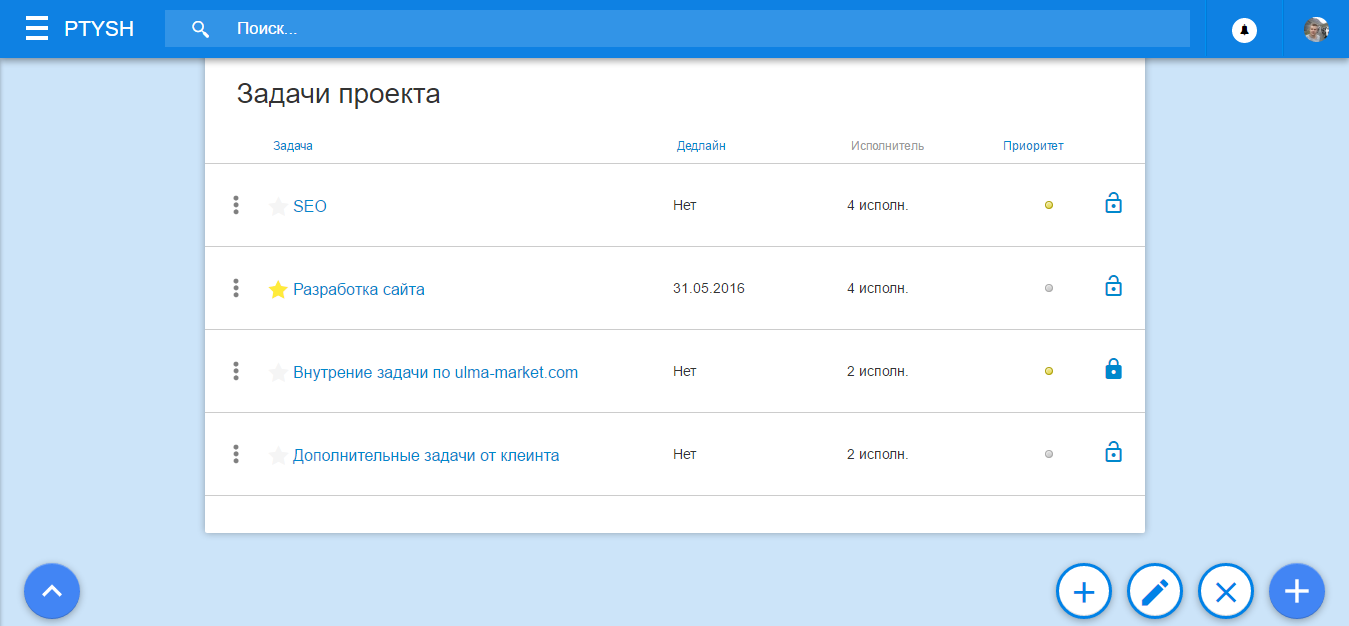The main rules of communication technician in a web studio with a client
Hi, Habr! Now I want to touch on the topic of customer communication with technical specialists of Web studios and SEO companies. Although, I think this question is relevant for all companies that are related to technology - after all, the customer speaks a priori a different language. As practice shows, the client rarely wants to spend his time completing the TK and, moreover, does not want to delve into the development or the essence of the proposed service. He wants to get what his imagination painted with a wave of a magic wad of money. As a result, any ventured to take on the development of the performer can do what the client does not like. Today, this approach to development is gradually disappearing, the client is getting smarter and becoming the basis of his desires is not just to make it beautiful and impressive, but also to make it work like clockwork and bring income. But even here extremes often happen - the client begins to consider himself a super pro. How to find balance and survive in the process of communication with the customer, we will try to figure it out.

In addition to detailed examinations and technical tasks for a quality website, the client’s direct participation is necessary, only he can fully tell about his service, reveal its positive and negative sides, and tell about the intricacies of his business. This is very important because the site is the face of the company on the Internet and is intended to reflect its values. That is why even before creating a technical task, it is necessary to ask the client to fill out a brief, which will collect information about the preferences of the customer. That is what must be present in the brief.
Filling the brief will help you to estimate the cost of the project as adequately as possible, give you an understanding of the details, and help the customer once again to rethink their requirements. By the way, do not forget to indicate in the brief that all the information received will be kept in the strictest confidence - this increases the chances of a fair filling.
Do you know when a client wants to get his message across the phone? And the conversation usually comes down to “Well, I don’t know, do as you see fit,” or “What do you think is better placed there?”
Or when edits to the layout are in the mail, skype, and some are dictated on paper at the meeting? Or, which is no happier, do you have a recording of the conversation that you have to listen to with interjections, water, and a story about the weather?
The problem is, we lived with her and created her decision. In short, for the duration of the project, we become employees of the client, and the client becomes our employee. We have common goals, objectives and a single project management system. No frills and frills - all of the case.

Why is this? First, we briefly break the development of the site into stages (using the example of DFAKTOR developments).
These stages tightly connect you with the customer and your duty is to do the job qualitatively and to provide reports on what was done (you can simply in the form of a check list). Such an approach will recommend you as a reliable partner and, in addition to everything, in case of force majeure, you will be able to reasonably move the dates.
First, we present a short check-list of the rules of communication, and then we will tell you how we ourselves gracefully solved the problem. So, not to make the client your enemy.
Here you can use any task management system that meets the requirements and has the possibility of external access, I will tell you how it happens with us using the example of PTYSH .
When concluding a development contract, be sure to list how the information should come from the client. The contract should be strictly spelled out that any comments, improvements and requests from the client are recorded only through the problem book. The client must receive a quality product, so it will have to be disciplined. You should spend time developing, not collecting information from different sources. The client can call, write to the mail or Skype - but if he wants the task to be completed, it must be recorded in the task book.
You will spend 2 minutes to register a client and send him a username and password.

Then we start a new project, in which each stage of development is painted with separate tasks and has its own performer. An analyst for expertise, a layout designer for a layout, a designer for a design. Each task and development stage has a deadline of violation of which is strictly punished :) Everyone knows his own business, a specific time is allotted for each case. For each task, all comments are collected in one place only. This is an ideal control system for the head of the Web Studio and an excellent guarantee of quality and meeting the deadlines for the customer.
In order not to produce separate projects for employees and clients, you can hide the internal tasks of the company and they will not be visible to the client.

And finally, the same approach should be used for projects on SEO promotion or the implementation of any advertising campaign.
Each client of the company has access to the personal account of PTYSH , in which he can view the results of work, leave his comments and suggestions. In this case, nothing will be lost and all work will be completed on time.
The main rule of communication of technical specialists with web studio clients is as little communication as possible in the development process. The thought of the customer, clearly outlined in the text, takes 10 times less paid specialist time than explaining it by phone. In addition, a written statement makes one speak briefly and thoughtfully, it is not for nothing that they say who writes - he reads twice.
And finally - the boyfriend as an epic developer dialogue with the client :)

Disclaimer
Habr is not familiar with us, we came here with Megamind. We are the St. Petersburg company DFAKTOR and her favorite child is the project management system for Ptysh web-studios, which we have not just programmed, but suffered through the search for the best. About who we are and what Ptysh is, you can read here . A treatise on the painful choice of a project management system is here (taken apart by the bone). By the way, Ptysh is free :-)
What is the brief - so is the creative
In addition to detailed examinations and technical tasks for a quality website, the client’s direct participation is necessary, only he can fully tell about his service, reveal its positive and negative sides, and tell about the intricacies of his business. This is very important because the site is the face of the company on the Internet and is intended to reflect its values. That is why even before creating a technical task, it is necessary to ask the client to fill out a brief, which will collect information about the preferences of the customer. That is what must be present in the brief.
- Description of the company - while presenting his business, a person projects an attitude towards him onto the text, demonstrates the level of professionalism.
') - The story about the product, its consumers, competitors and place on the market - this information will form the basis of the content.
- Preferences on the structure of the site: whether you need a news section, blog, banners, advertising space, a place for reviews. Perhaps a wish will come to light about which neither you nor the client suspected.
- The story of the strengths and weaknesses of the product. This is important for building the structural strategy of the site - moreover, sometimes an honest story about their shortcomings makes the company almost invincible and leaves no chance for competitors to throw mud at it. When working on a site layout, a copywriter and a project manager must take this into account.
- Examples of sites of similar subjects that the customer likes are very useful information, it can be used to judge customer preferences, and at the same time assess how adequately the project budget and expectations from it are. Agree, if with a budget of 60 000 rubles, you are asked to site “well, like the type of OZON”, it is alarming.
- Wishes of the client on color scale and the general tonality of content and visualization. This is also critical information, since the site must correlate even with the client’s communication style. And if the company adopted an artsy officiality, and the site will be with comics and fonts, the commercial success of the project is questionable.
Filling the brief will help you to estimate the cost of the project as adequately as possible, give you an understanding of the details, and help the customer once again to rethink their requirements. By the way, do not forget to indicate in the brief that all the information received will be kept in the strictest confidence - this increases the chances of a fair filling.
I'll be brief, forty minutes
Do you know when a client wants to get his message across the phone? And the conversation usually comes down to “Well, I don’t know, do as you see fit,” or “What do you think is better placed there?”
Or when edits to the layout are in the mail, skype, and some are dictated on paper at the meeting? Or, which is no happier, do you have a recording of the conversation that you have to listen to with interjections, water, and a story about the weather?
The problem is, we lived with her and created her decision. In short, for the duration of the project, we become employees of the client, and the client becomes our employee. We have common goals, objectives and a single project management system. No frills and frills - all of the case.

Why is this? First, we briefly break the development of the site into stages (using the example of DFAKTOR developments).
- Expertise. At the stage of examination, we must clearly understand the target audience of the client, understand its needs, analyze competitors. Our task is to make a site that will answer all your questions and help you make a transaction, the site’s logic should not be distracting, it should help sell and sell. The result of the examination is a list of required elements of the site, prohibited elements of the site and possible scenarios of customer behavior, as well as prototypes of pages.
- Technical task. All the accumulated information is collected in the technical task, the composition of typical templates and the functions of all pages are described in detail. Wishes in appearance (if they do not contradict the results of the examination), SEO specialist comments. The technical task should be written in a language that is understandable to both parties, without contradictions and collisions. It should reflect all wishes: from the favicon to the contacts. Remember: TK is your lawyer, in the case of the slightest dispute, you can calmly appeal to the signed document and boldly ask for money for everything above.
- Development of the layout of the main page.
- Development of internal page layouts.
- Development of the layout for the mobile version of the site.
- Creating an adaptive layout
- Integration with CMS and programming.
- Testing - should be carried out both by the studio and by the customer. Especially important if we are talking about an online store or site with the possibility of purchase - the managers of the client and he must confirm that everything is designed and working correctly.
- Starting and debugging - the stage of start and primary support of the site, if it is provided by the contract By the way, one of the most paranoid stages when each hang seems to the customer a major bug. Collect it carefully and, preferably, also in writing - you can send a report on the correction, and then write a manual for customers on how to work with the site. This will save you from a flurry of calls, angry letters and outraged chat. However, who am I kidding - it's easier to call than to read the instructions :-)
These stages tightly connect you with the customer and your duty is to do the job qualitatively and to provide reports on what was done (you can simply in the form of a check list). Such an approach will recommend you as a reliable partner and, in addition to everything, in case of force majeure, you will be able to reasonably move the dates.
And secondly, directly about communications
First, we present a short check-list of the rules of communication, and then we will tell you how we ourselves gracefully solved the problem. So, not to make the client your enemy.
- Record all interactions (record conversations, write or communicate in writing in a project management system or CRM).
- Make the course of work transparent for the client - if he will track the progress on his own, you will stop pulling.
- Do not lie to the client - even the processors break down and are mistaken. If deadlines fail or there are problems, state them to the client, telling about the reasons. Surprisingly, sometimes the decision may come from the customer.
- Put unambiguous questions requiring an unambiguous answer.
- Require a dedicated manager from the client - do not allow anyone to talk with you.
- Sign a technical task.
- Negotiate deadlines for the submission of edits, comments and comments from the customer.
- Negotiate the terms, conditions and amounts of technical support after the launch of the site.
Here you can use any task management system that meets the requirements and has the possibility of external access, I will tell you how it happens with us using the example of PTYSH .
When concluding a development contract, be sure to list how the information should come from the client. The contract should be strictly spelled out that any comments, improvements and requests from the client are recorded only through the problem book. The client must receive a quality product, so it will have to be disciplined. You should spend time developing, not collecting information from different sources. The client can call, write to the mail or Skype - but if he wants the task to be completed, it must be recorded in the task book.
You will spend 2 minutes to register a client and send him a username and password.

Then we start a new project, in which each stage of development is painted with separate tasks and has its own performer. An analyst for expertise, a layout designer for a layout, a designer for a design. Each task and development stage has a deadline of violation of which is strictly punished :) Everyone knows his own business, a specific time is allotted for each case. For each task, all comments are collected in one place only. This is an ideal control system for the head of the Web Studio and an excellent guarantee of quality and meeting the deadlines for the customer.
In order not to produce separate projects for employees and clients, you can hide the internal tasks of the company and they will not be visible to the client.

And finally, the same approach should be used for projects on SEO promotion or the implementation of any advertising campaign.
Each client of the company has access to the personal account of PTYSH , in which he can view the results of work, leave his comments and suggestions. In this case, nothing will be lost and all work will be completed on time.
The main rule of communication of technical specialists with web studio clients is as little communication as possible in the development process. The thought of the customer, clearly outlined in the text, takes 10 times less paid specialist time than explaining it by phone. In addition, a written statement makes one speak briefly and thoughtfully, it is not for nothing that they say who writes - he reads twice.
And finally - the boyfriend as an epic developer dialogue with the client :)
Source: https://habr.com/ru/post/300992/
All Articles